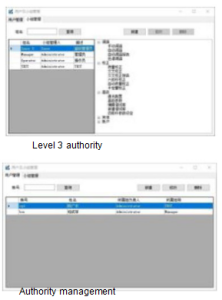
Products
Customized digital/analog dual-mode detector with dynamic range of 10 or more orders of magnitudes.
The creative 5-channel collision reaction gas is built-in, and up to 10 high-precision MFCs can be configured, with multiple choices and fast switching, making it more convenient and flexible to use.
The ion transmission system with 90° off-axis design can completely eliminate the interference of neutral particles and improve the signal-to-noise ratio while efficiently transmitting ions.
The world's first vertical torch
The vertical torch design is introduced in ICP-MS for the first time, which greatly reduces the accumulation of salt in the torch, prolongs the service life of the torch, and solves the problem of analyzing high-salt complex matrix samples. At the same time, argon consumption is greatly reduced, and heat and exhaust gas naturally enter the exhaust system upward, requiring less cleaning and less downtime.
The unique patented dual RF power supply has the fastest impedance matching mode, which makes the response faster and the anti-interference ability stronger. Without any moving parts, it provides a more stable ICP torch, and improves the stability of the analysis while being small in size. It can be directly injected to analyze 100% ethanol and other highly volatile organic compounds.
Combined with ultra-high matrix direct injection system and organic injection system, it can ensure long-term stable and reliable analysis in any complex matrix.
The unique self-excited all-solid-state RF source provides cold flame mode as low as 500w, reduces the ionization of Ar-based ions, improves the signal-to-noise ratio of analyte ions such as 39K+, 40Ca+, 56Fe+, and the lower limit of detection of elements is greatly extended.
With the matrix-resistant vertical ion plasma design, combined with the new generation of self-excited all-solid-state RF power supply and the ultra-high matrix direct injection system, it can still guarantee the long-term stability of the instrument even in the face of soil solution with complex matrix, to avoid signal drift caused by the matrix and ensure the accuracy and reliability of data.

Excellent structural design makes the mass spectrometer with superior performance



EXPEC 7350 ICP-MS/MS gives full play to the potential of the collision reaction cell. The five-channel collision reaction gas combined with MS/MS mode can ensure sensitivity, completely eliminate interference, and obtain accurate results even when analyzing samples with extremely complex matrices:



Incredible interference removal capability
It has been proved that the traditional ICP-MS matching He kinetic energy discrimination (KED) effect can effectively eliminate polyatomic interferences in high-matrix samples. However, it cannot eliminate mass spectrum interferences such as isobaric numbers and double charges, and its application range is limited.
In the traditional ICP-MS reaction mode, a large number of unknown ions enter the collision reaction cell and react together with the target ions, generating many by-product ions that form new interferences and causing deviations of the analysis results. The new generation of EXPEC 7350 MS/MS mode adds a quadrupole filter (TQQ1) before the collision reaction cell. TQQ1 only allows the target ions to enter the collision reaction cell and completely eliminates other interferences, greatly improving the sensitivity and signal-to-noise ratio, perfect for all applications.

In the traditional ICP-MS reaction mode, the interference of 59Co16O+, 150Nd++ and 150Sm++ can be eliminated, but the interference of 91Zr+ cannot be eliminated, resulting in false positive results.

In the new-generation triple quadrupole ICP-MS mass transfer mode, TQQ1 only allows ions with a mass-to-charge ratio of 75, such as 59Co16O+, 150Nd++, and 150Sm++, to pass into the collision reaction cell, where 75As+ is transformed into 75As16O+. TQQ2 analysis mass number is set to 91 of 75As16O+, and 91Zr+ interference has been eliminated at TQQ1 and will not interfere with the analysis results.
EXPEC 7350 ICP-MS/MS Analysis of ultra-trace sulfur in high purity reagents
It has always been difficult to analyze ultra-trace sulfur. During spectral analysis, the characteristic spectral line of sulfur (S) element belongs to the ultraviolet region, with poor sensitivity and high detection limit, which cannot meet the analysis requirements of ultra-trace sulfur in high-purity reagents. When using conventional ICP-MS, the sulfur element is less ionized, resulting in lower analysis signal. Only 32S+ with high abundance can be selected as the target ion, and 32S+ is seriously interfered by 32O2+. In the traditional ICP-MS reaction mode, 32S+ is transformed into 32S16O+ by mass transfer for analysis. At the same time of mass transfer, there will be new interference such as 48Ti+, 48Ca+, 12C18O2+, etc., so it is still impossible to realize the accurate analysis of ultra-trace sulfur.
The new generation of ICP-MS/MS adds an additional quadrupole mass filter (TQQ1) before the collision reaction cell. TQQ1 controls the ions that can enter the reaction cell to ensure that the reaction process in the cell is controllable. In this way, the interference of non-target product ions formed by matrix elements and other analyte ions can be avoided, and the detection limit below ppt level can be easily achieved to meet the test requirements of limit analysis.

In the traditional ICP-MS reaction mode, the spectrum at the mass-to-charge ratio of 48 is shown in the figure above. After mass transfer, the target product ion 32S16O+ is subject to two new interferences such as 48Ti+, 48Ca+, and 12C18O2+, which cannot effectively remove the interference encountered during sulfur element analysis, and cannot meet the analysis requirements of ultra-trace sulfur in ultra-pure reagents.
In MS/MS mode, all interferences such as 48Ti+, 48Ca+, 12C18O2+, 12C+ will be eliminated first in TQQ1, so that accurate analysis results can be obtained in reaction mode. The 32S16O+ mass spectrum is shown in the figure above, all interference peaks are excluded, and there is no interference of overlapping peaks, indicating that ICP-MS/MS can effectively solve the problem of ultra-trace sulfur analysis in high-purity reagents, and realize the accurate analysis of ppt and sub-ppt sulfur elements.

Analysis of trace arsenic in whole blood and serum by EXPEC 7350 ICP-MS/MS
The normal concentration level of arsenic in blood and serum is extremely low, and severe matrix interference is often encountered in ICP-MS analysis. In the past few decades, one of the most important improvements to inductively coupled plasma mass spectrometry has been the introduction of collision/reaction cells to remove polyatomic interferences. However, there are still many challenges in the determination of ppt-level arsenic in complex matrices such as blood or serum by ICP-MS with a collision reaction cell. For example, in the collision mode, although 75As+ can avoid the interference of 35Cl40Ar+, it will still be interfered by 150Nd++ and 150Sm++; in the reaction mode, 75As16O+ is also inevitably interfered by 91Zr+, 51V40Ar+ and 152W++, which cannot be effectively and completely removed, resulting in analysis errors.
However, the ICP-MS/MS with two mass screenings does not have such problems, and can easily obtain detection limits below the ppt level in complex matrices such as blood.

In the traditional ICP-MS reaction mode, the spectrum at the mass-to-charge ratio of 91 is shown in the figure above. After mass transfer, the target product ion 75As16O+ is subject to new interferences such as 91Zr+, 51V40Ar+, and 182W++. Therefore, traditional ICP-MS cannot effectively remove the serious interference caused by complex matrices, and cannot meet the analysis requirements of trace arsenic in whole blood.
In MS/MS mode, all interferences such as 91Zr+, 51V40Ar+, 182W++, etc. will be eliminated first in TQQ1, so that accurate analysis results can be obtained in reaction mode. The 75As16O+ mass spectrum is shown in the figure above, all interference peaks are excluded, and there is no interference of overlapping peaks, indicating that ICP-MS/MS can effectively solve the problem of trace arsenic analysis in whole blood and serum, and realize the accurate analysis of ppt and sub-ppt arsenic elements.

For the analysis of trace Mn in Fe matrix, 55Mn+ can only be selected as the target ion analysis because Mn does not have isotopes. 55Mn+ is prone to serious interference from the trailing peaks of 54Fe+ and 56Fe+ of the main element, which brings great troubles to the traditional ICP-MS analysis of trace Mn in Fe matrix.
The new generation ICP-MS/MS of Expec Technology is equipped with 90° off-axis and triple quadrupole pre-pole, which reduces the probability of ion collision during transmission, achieves extremely low background noise and unparalleled sensitivity, and increases the abundance sensitivity by more than two orders of magnitude, perfectly solving the interference of adjacent trailing peaks, and meeting the accurate analysis requirements of trace elements in complex matrices.
In the traditional ICP-MS reaction mode, the spectrum at the mass-to-charge ratio of 55 is shown in the figure above. 55Mn+ is seriously interfered by the tail peaks of adjacent mass numbers 54Fe+ and 56Fe+. The traditional ICP-MS cannot effectively remove the interference caused by adjacent component peaks in the analysis of manganese element, resulting in much higher analysis results.


In MS/MS mode, the excellent abundance sensitivity can perfectly separate the mass spectrum peaks of adjacent mass numbers and eliminate interference. The mass spectrum of 55Mn+ is shown in the figure above. The peaks of adjacent components are separated without the interference of overlapping peaks, indicating that the excellent abundance sensitivity of ICP-MS/MS can effectively solve the problem of trace manganese analysis in iron matrix.
Rapid injection system

The combination of ultra-high performance liquid chromatography and ICP-MS technology can realize the speciation and valence analysis of mercury, tin, lead, arsenic and chromium in samples.

Based on the combination of graphite furnace electrothermal evaporation technology and ICP-MS technology, solid samples can be directly injected and analyzed without digestion, which greatly improves the analysis efficiency. It is a typical green analysis technology.

The combination of super microwave and ICP-MS technology forms a set of automatic heavy metal analysis system, which can realize the automatic processing of the whole process of sample pretreatment, analysis and report, and liberate the laboratory manpower.

Leave your needs, we will get in touch with you as soon as possible!